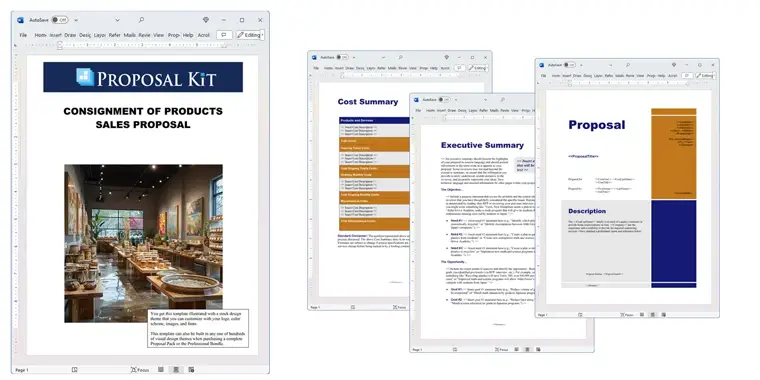How to write your Consignment of Products Sales Proposal
We include this 14 page layout with every Proposal Pack. If you want this template to have a different visual design theme than the one illustrated here, purchase any Proposal Pack design and create this template using the purchased design theme. This template is included in every Proposal Pack. If you get a Proposal Pack or the Professional Bundle, you can also make any variation of this template with different chapters to suit your needs.
We typically include more chapters in the templates than most people will need to give everyone more variety in the chapters they may need. You can trim down a long template by removing pages you do not need or combining multiple chapter topics into one page.
 DOWNLOADABLE, ONE-TIME COST, NO SUBSCRIPTION FEES
DOWNLOADABLE, ONE-TIME COST, NO SUBSCRIPTION FEES If you need this template on DVD media order from our Amazon shop.
If you need this template on DVD media order from our Amazon shop.
You can also create countless variations of this document to suit your needs using the included library of 2200+ chapters if ordering a Proposal Pack or Pro Bundle.
 What Our Clients Say
What Our Clients SayI purchased proposal pack some years back when i was asked at work to write a proposal to implement a new program at work. Document was well received and I was even asked to present it to the president of the company. It saved me lots of time and removed all the guess work. I’ve been an avid user for about 3 years now and would still recommend it to anyone."
Business executive - Operations Management, Business Development and Entrepreneurial Leadership
Related Article
Related Video
Related Templates
- Artist Gallery Consignment Sales Proposal
- Procurement and Consignment Services Proposal
- Product Sales Proposal
- Product Sales Proposal (Short)
- Product Sales Proposal (Long)
- Product Manufacturer Proposal
- Product Supply RFP Response Proposal
- Product and Service Proposal
- Sales Quota Improvement Proposal
Writing the Perfect Consignment of Products Sales Proposal
Standing out requires more than just an excellent product-it requires a compelling consignment of product sales proposal to make your pitch. For those unfamiliar with writing proposals, the task might seem overwhelming. A proven way to approach this, especially for new writers, is by utilizing the Proposal Kit software and template library. Proposal Kit simplifies the process, offering a comprehensive solution with a line item quoting database system for detailed financial documentation, such as cost summaries, quotes, estimates, and budgets.
Do you need to draft a proposal to consign your products to a store, gallery, or chain?
What Types of Projects Are Consignment of Products Sales Proposals Written For?
Consignment sales may be a good idea for some types of businesses. Consignment of product sales proposals can cover a wide array of projects, including but not limited to:
- Introducing a new product line to retail stores.
- Expanding the distribution of handmade crafts.
- Launching eco-friendly goods in environmentally conscious shops.
- Selling high-end furniture on consignment in luxury stores.
- Offering local artisan products to tourist shops.
- Placing educational toys in children's stores.
- Marketing designer clothing to boutique shops.
- Supplying tech gadgets to electronic retailers.
- Distributing specialty food items to gourmet markets.
- Providing fitness gear to sports outlets.
Chapters this template is built with
Proposal Kit's templates guide users through creating a sales proposal, ensuring all necessary components are covered. Here's how specific chapter templates can enhance your proposal.
Together, these sections form the backbone of a consignment of products sales proposal. By addressing each area, you create a comprehensive document presenting your products in the best possible light and outlining the consignment agreement's specifics, building a solid foundation for a successful partnership.
These templates allow you to create a customized proposal that addresses all the topics you need to discuss. Once finished, the proposal can be saved as a PDF file for easy delivery.
Cover Letter: Your Proposal's Handshake
A well-written cover letter is like a firm handshake: it sets the tone for the interaction and starts the conversation on the right foot. In your cover letter, personalize your greeting to address the recipient directly, showing that you have done your homework. Briefly mention what your proposal will cover and express enthusiasm about the potential partnership. This initial touch personalizes your introduction and establishes a welcoming tone, inviting the reader to delve deeper into your proposal.
Introduction: Setting the Stage
The introduction serves as the stage-setter for your proposal. Here, clearly outline the purpose of your proposal, introducing your business and the unique product line you wish to place on consignment. This section is crucial for setting the context of your proposal, providing the reader with a clear understanding of what you are offering and why it matters. The introduction lays the groundwork for the detailed information that follows.
Fee Structure: Laying Out the Financials
The fee structure section details the consignment fee or percentage you are proposing, along with any other related costs that might affect the retailer. Being transparent and upfront about the financial aspects of the consignment agreement helps build trust and facilitates a smoother negotiation process. Explain how these fees were determined and how they compare to industry standards, justifying your proposed structure.
Advantages: The Win-Win Scenario
It is vital to highlight the advantages for the store in carrying your products. Explain how your products will attract more customers, enhance the store's reputation, or complement the existing product range. This section is about showcasing the mutual benefits, ensuring the retailer understands the value your products add to their business.
Price List: Detailing Your Offerings
A comprehensive price list details the costs associated with each product and provides transparency, aiding in the decision-making process. Include wholesale and suggested retail prices if applicable, and be sure to mention any volume discounts or special offers. This list gives the retailer a clear picture of your product range and pricing structure.
Payment Options: Clarifying Financial Transactions
Explaining how payments will be handled under the consignment agreement is crucial for avoiding misunderstandings later. Whether payments will be made after each sale, monthly, or at another agreed-upon interval, clear communication on payment options and schedules ensures that both parties are on the same page.
Products: Showcasing Your Range
Describing the products you are offering involves more than just listing items; it's about highlighting their features and benefits. For each product, mention what makes it unique, its quality specifications, and why it appeals to your target market. This section is your opportunity to spotlight your product range and its appeal.
Product Visuals: Bringing Your Products to Life
Including images of your products can significantly enhance your proposal. Visuals provide a clearer understanding of your offer, allowing readers to envision your products in their store. High-quality images showcasing your products in the best light can substantially improve the quality of your pitch.
Consignment: Defining the Agreement
The consignment section outlines the specific terms of your agreement, such as the duration of the consignment, inventory management practices, and sales tracking mechanisms. Clear terms help manage expectations and lay the foundation for a successful partnership. Detailing how unsold goods will be handled is also essential.
Dealers: Building Your Network
Introducing potential dealers or stores plays a crucial role in illustrating the expansion of your distribution network. Mention any successful partnerships, as their significance can bolster your proposal's credibility. This shows potential new partners in the broader context of your product distribution and success.
About Us: Connecting on a Personal Level
Sharing your business's story, mission, and vision helps create a personal connection with the reader. This section is about more than just what you do; it's about why you do it. By conveying your passion for your products and business, you invite the reader to become part of your journey, making your proposal more compelling.
Use cases for this template
Elena's Furniture Business Venture: Writing Success
A blend of passion for craftsmanship and an entrepreneurial spirit drove Elena's journey into consignment sales. Recognizing the potential of her handcrafted furniture in a broader market, she faced the pivotal challenge of articulating this value in a business proposal. Elena's partnership with Proposal Kit was transformative.
It offered her a structured pathway to translate her vision into a compelling narrative, embedding her furniture's uniqueness and high-quality essence into every proposal section. Her meticulously written proposal outlined the aesthetic and functional appeal of her pieces and integrated robust financial planning and strategic promotional strategies.
These elements collectively painted a vivid picture of mutual growth and success, ultimately convincing a chain of stores to embark on a lucrative consignment agreement with her. Elena's story exemplifies how effective communication and a clear understanding of market dynamics can turn potential into prosperity.
Jay's Proposal Deadline
Jay's scenario is a testament to the power of leveraging modern technology to meet deadlines. While creating a detailed consignment proposal, Jay found his solution in the synergy between the Proposal Kit and an AI writing tool. This innovative approach allowed him to quickly produce a draft, which he refined and structured into a coherent, persuasive proposal. The AI tool, informed by crucial product information, catalyzed the content creation, while the Proposal Kit provided the necessary framework and polish.
This strategic use of technology-enabled Jay to meet his deadline and exceed expectations, securing a new consignment opportunity for his company. Jay's experience underscores the significance of adaptability and the intelligent integration of digital tools in overcoming business challenges.
Maria's Mission for Local Artisans: Empowering Communities
Maria's mission transcended the simple goal of selling products: creating a sustainable economic pathway for rural artisans. To convince tourist shops to feature locally handcrafted goods, Maria leveraged Proposal Kit to build a persuasive argument grounded in mutual benefit and social responsibility.
Her proposal detailed the unique value and cultural significance of the artisan products, framing them as items for sale and stories and traditions to be shared. Through Proposal Kit's structured approach, Maria highlighted the potential for these unique products to attract a diverse customer base seeking authentic experiences, benefiting the stores while supporting rural communities.
Her successful proposal facilitated partnerships that brought artisan goods to a broader audience, generating vital income for local creators. Maria's story is a powerful example of how well-written proposals can bridge diverse markets and communities, fostering economic opportunities and cultural exchange.
Conclusions and Recommendations
Each situation illustrates the diverse ways the Proposal Kit can address and overcome the unique challenges of drafting a consignment of products sales proposal. From capturing the essence of handcrafted furniture to navigating tight deadlines and supporting local artisans, the Proposal Kit is a versatile tool, empowering entrepreneurs, employees, and volunteers to achieve their goals and drive meaningful impact.
Also Known As
This template may also be referred to in different ways or be used in more specialized situations, such as:
- Product Distribution Agreement Proposal
- Goods Supply Partnership Offer
- Inventory Consignment Offer Document
- Retail Merchandise Placement Proposal
- Vendor Managed Inventory Agreement
- Stock Consignment Arrangement Proposal
- Consignment Sales Agreement Submission
- Reseller Partnership Proposal
- On-Consignment Supply Proposal
- Consignment Inventory Sales Offer
Abstract
 Creating a consignment of products sales proposal is important for businesses seeking to establish or expand their consignment relationships. Such proposals outline the consignment agreement terms for selling goods on behalf of the consignor, ensuring that both the consignee and consignor agree on important topics like pricing, payment plans, and consignment arrangements. The consignment agreement constitutes a legal document that clarifies the obligations of the parties involved and governs the entire agreement under applicable laws. By using tools like Proposal Kit, businesses can save time and effort by creating comprehensive and customized proposals that detail the consignment sale process, from the quality standards of merchandise sold to the necessary insurance coverage and other provisions.
Creating a consignment of products sales proposal is important for businesses seeking to establish or expand their consignment relationships. Such proposals outline the consignment agreement terms for selling goods on behalf of the consignor, ensuring that both the consignee and consignor agree on important topics like pricing, payment plans, and consignment arrangements. The consignment agreement constitutes a legal document that clarifies the obligations of the parties involved and governs the entire agreement under applicable laws. By using tools like Proposal Kit, businesses can save time and effort by creating comprehensive and customized proposals that detail the consignment sale process, from the quality standards of merchandise sold to the necessary insurance coverage and other provisions.
In creating the perfect consignment sales proposal, careful attention is given to the inclusion of all necessary parties and their expectations. The document outlines the consigned goods, their full purchase price, and the method by which the consignee agrees to remit payment. It is crucial to clarify the basis of the consignment, ensuring that the consignor retains ownership of the products until they are sold. Each proposal should include a consignment inventory form to help with record-keeping and risk management associated with damage occurring during storage or display. Clear communication through a written agreement, with prior written consent where needed, aids in establishing a reliable agency relationship between the two parties.
Revisiting the detailed topics of consignment agreements, it is vital to focus on the consignment contract, which provides exclusive rights for selling specific products. Highlighting the products' unique features and benefits enhances their attractiveness to potential buyers. The consignment terms should clarify the time frame and termination conditions, ensuring that either party can proceed with any necessary amendments or notices in case disagreements arise. Legal help is recommended to navigate the complexities of clauses related to governing law, confidential information, indemnification, and warranties.
 By addressing these topics, businesses can produce a proposal that not only captures their product's value but also ensures a smooth partnership with consignment stores. Additionally, the use of related templates can assist in customizing each proposal to suit specific needs and desires, whether the goal is to expand the distribution of handmade crafts, supply tech gadgets to electronic retailers, or place educational toys in children's stores. Ultimately, a well-written proposal can turn potential into mutually beneficial partnerships, facilitating the sale of consigned items and fostering long-term business success.
By addressing these topics, businesses can produce a proposal that not only captures their product's value but also ensures a smooth partnership with consignment stores. Additionally, the use of related templates can assist in customizing each proposal to suit specific needs and desires, whether the goal is to expand the distribution of handmade crafts, supply tech gadgets to electronic retailers, or place educational toys in children's stores. Ultimately, a well-written proposal can turn potential into mutually beneficial partnerships, facilitating the sale of consigned items and fostering long-term business success.
A consignment of products sales proposal serves as a foundational tool in establishing a partnership between a consignor and a consignee. Beyond merely listing products, it sets forth a consignment contract outlining the terms under which certain products are transferred to the consignee for sale. This legal document is governed by applicable laws and must include clear consignment terms. These terms address the responsibilities of both parties, ensuring that the consignee agrees to sell goods on the consignor's behalf while the consignor retains ownership until the merchandise is sold.
The proposal must be thorough, detailing each party's obligations, including the full title of consigned goods and any insurance coverage required to mitigate risks like damage occurring during storage or transport. A carefully constructed consignment agreement template can serve as a guide, helping parties involved to agree on significant topics such as the purchase price, payment plan, and the governing law. This agreement constitutes the entire agreement and should accurately reflect the quality standards and exclusivity rights intended by both the consignor and consignee.
 Including a consignment inventory form within the proposal aids in maintaining accurate records of consigned items. This record-keeping is crucial for managing inventory and ensuring accountability for both sold goods and unsold inventory. Additionally, provisions must be set for the handling of unsold goods, including the process for their return or further disposition. Such goods, if not sold within the agreed time period, remain in the consignor's possession or are returned as per the written agreement.
Including a consignment inventory form within the proposal aids in maintaining accurate records of consigned items. This record-keeping is crucial for managing inventory and ensuring accountability for both sold goods and unsold inventory. Additionally, provisions must be set for the handling of unsold goods, including the process for their return or further disposition. Such goods, if not sold within the agreed time period, remain in the consignor's possession or are returned as per the written agreement.
When creating the proposal, it is vital to consider the potential for disagreements and set forth a clear process for dispute resolution, whether through arbitration or other means. All clauses, including those for confidentiality and indemnification, must be tailored to meet each party's interests, ensuring that both the consignor and consignee are protected against unforeseen circumstances.
To enhance the attractiveness of the proposal, sellers should focus on the advantages their products offer to consignment stores. For instance, introducing exclusive products to boutique shops or placing unique handmade crafts in tourist shops can be a strong selling point. Sellers should aim to promote their product line by showcasing its potential to attract customers, complement existing offerings, or capitalize on current market trends.
-1200.webp) Consult your attorney to review any contracts and agreements before putting them to use. Proposal Kit documents are not legal advice, and any agreements included are for self-help purposes only.
Consult your attorney to review any contracts and agreements before putting them to use. Proposal Kit documents are not legal advice, and any agreements included are for self-help purposes only.
Finally, the inclusion of visual topics, such as high-quality images or videos, can greatly enhance a proposal's appeal. These visuals can help the other party envision the products in their retail environment, thereby increasing the likelihood of acceptance. The proposal should also be accompanied by a cover letter, setting a professional tone and providing a concise overview of what the proposal entails. By following these guidelines, businesses can produce a consignment sales proposal that not only meets legal and professional standards but also stands out in competitive markets, fostering successful consignment relationships.
Frequently Asked Questions
What should be included in a consignment sales proposal?
A consignment sales proposal should include several essential elements: an introduction that outlines the purpose and scope of the proposal, a detailed description of the products being offered, the terms and conditions of the consignment agreement, pricing and payment terms, responsibilities of both the consignor and consignee and any legal considerations. Additionally, it should provide an overview of potential benefits for the consignee, such as increased product variety or lower inventory costs, to make the proposal more compelling.
How do I determine the pricing structure for consigned products?
Determining the pricing structure for consigned products involves considering the cost of goods, potential retail price, and the margin needed to cover expenses and generate profit. Typically, the consignor (supplier) and consignee (retailer) will agree on a wholesale price, with the consignee taking a pre-agreed percentage of the sale price as their commission. It's essential to conduct market research to ensure the pricing is competitive and profitable for both parties.
What legal aspects should a consignment sales proposal address?
A consignment sales proposal should address several vital legal aspects to protect both parties. These include clearly defining ownership of the products, liability for loss or damage, terms for unsold inventory returns, and the duration of the consignment period. Additionally, it should outline the dispute resolution process and include any necessary clauses related to the termination of the agreement. Consulting with a legal professional can ensure that all legal considerations are thoroughly covered.
How do I make my consignment sales proposal stand out to potential retailers?
To make your consignment sales proposal stand out, focus on clearly articulating your products' unique value proposition and how they will benefit the retailer. Highlight any competitive advantages, such as superior quality, distinctive features, or strong market demand. If available, include testimonials or case studies from other successful consignments. Additionally, ensure that the proposal is well-organized, professionally formatted, and error-free to convey a sense of reliability and professionalism.
What should I include in the introduction of my consignment sales proposal?
The introduction of your consignment sales proposal should provide a concise overview of your business and the proposal's purpose. Start with a brief description of your company, including its history, mission, and core values. Then, introduce the products you offer for consignment, highlighting their key features and benefits. Conclude the introduction by stating the proposal's goal, establishing a mutually beneficial consignment agreement, and expressing your enthusiasm for the potential partnership.
15% Off Discount
![]() Add To Cart This Word Template Only
Add To Cart This Word Template Only
 Add To Cart Proposal Pack for Any Business
Add To Cart Proposal Pack for Any Business
 Add To Cart Proposal Kit Professional Bundle
Add To Cart Proposal Kit Professional Bundle
 4.7 stars, based on 846 reviews
4.7 stars, based on 846 reviewsProposal Kit chapters used in this template
Cover Letter, Title Page, Table of Contents, Introduction, Products, Product Visuals, Dealers, Advantages, Consignment, Price List, Fee Structure, Payment Options, About Us, Back Page
Included Calculator Spreadheets
These Excel calculator spreadsheets are included with this template. If you purchase a Proposal Pack or the Professional Bundle, these proposal pages are generated using an automated line-item database in the included Wizard software. The calculator spreadsheets are intended for use when purchasing only the static Word template.
You use this proposal for
- General business proposal
- Non-technical proposal
- Product sales proposal
How to create this template with Proposal Pack Wizard
You can create this document using any of the logo-designed Proposal Packs. Pick any Proposal Pack with a logo design theme you like best; they will all work equally well. The Proposal Pack for Any Business is the pack with no extra added logos or colors - designed to be used plain or for you to customize with your logos and graphics.
The Proposal Pack design theme you purchase will determine the visual look of this template. The screenshot above only shows the plain generic design theme. Names and stories in examples are fictional; however, the templates are from real client use cases.
We include a library of chapters to be assembled based on your needs. All proposals are different and have different needs and goals. We designed Proposal Pack so you can customize the documents to suit your needs.
You will best create this document using the Proposal Pack Wizard - Expert Edition software to select this template and build it in the Proposal Pack logo design theme of your choice along with any desired customizations (such as adding additional chapters, removing unneeded chapters, changing the order of chapters, and importing your company logo). This template outlines a proposal for the described situation. Each user is responsible for typing in the actual content of the provided pages with their information to complete the proposal. Suggestions in the abstract may include features in higher-end packages and are facilitated by the selection of chapter templates to support the narrative of each proposal, which help guide the user in filling in the details.
You create this template using the Wizard software with an entire Proposal Pack library and software. We include the Expert Edition of the software in the Proposal Kit Professional bundle. Microsoft Word for Windows is required to use the customizing software. You can also edit Word document templates in other office software such as Word for Mac. We will assist Mac users in assembling complex templates for their first project if they do not have the required platform to run the Wizard software.
You only get the single assembled Word document if purchased as a stand-alone template. The individual template products include no other templates, samples, or software.
How to Build Templates Featured on Proposal Kit Website
Many people find the Proposal Kit website after searching for a specific proposal. Once you've purchased and installed the software, how do you build that template you found in the first place? This video shows you how to build any proposal you see on the Proposal Kit website.
Key Takeaways
- The Consignment of Products Sales Proposal is available as a ready-to-edit template.
- You can create unlimited custom variations of this template using a Proposal Pack or the Professional Bundle.
- Using a Proposal Pack or Professional Bundle, you can automate quotes and other financial pages with a line-item database.
- There are no ongoing subscription fees. You get lifetime unlimited use.
- We made Proposal Kit for freelancers, small businesses, and non-profits.
- Proposal Kit product content (templates, samples, software) is 100% written by humans.
 Ian Lauder has been helping businesses write their proposals and contracts for two decades. Ian is the owner and founder of Proposal Kit, one of the original sources of business proposal and contract software products started in 1997.
Ian Lauder has been helping businesses write their proposals and contracts for two decades. Ian is the owner and founder of Proposal Kit, one of the original sources of business proposal and contract software products started in 1997.By Ian Lauder
 Published by Proposal Kit, Inc.
Published by Proposal Kit, Inc.


 Cart
Cart


 Get 15% off ordering today:
Get 15% off ordering today: 

 Facebook
Facebook YouTube
YouTube X
X Search Site
Search Site